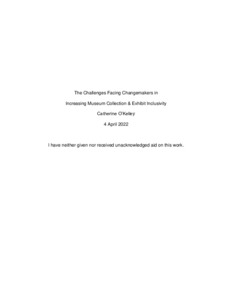The Challenges Facing Changemakers in Increasing Museum Collection & Exhibit Inclusivity (thesis)

View/
Author
O'Kelley, Catherine
Subject
Washington and Lee University -- Honors in Art History
Art museums
Cultural pluralism
Multiculturalism
Metropolitan Museum of Art (New York, N.Y.)
Smithsonian Institution
Virginia Museum of Fine Arts
Metadata
Show full item recordDescription
Thesis; [FULL-TEXT FREELY AVAILABLE ONLINE] Catherine O'Kelley is a member of the Class of 2022 of Washington and Lee University. Over the last forty years, growing demands from activists and stakeholders have increased pressure on museums throughout the United States to diversify their permanent collections, exhibitions and programming by including artists representative of the population and welcoming diverse audiences, representative of society at large. The calls for diversification come from internal and external stakeholders, including museum staff and boards, and broader, public demands for museums to support ongoing social change by modernizing museum collections, business practices, and visitor experiences to align to contemporary social norms, including gender, racial, and class equality. The Metropolitan Museum of Art, long considered the gold standard for US museums, embodies the challenges many arts institutions face in demonstrating the institutional flexibility and financial health required to adequately respond to calls for change. After attempting a wide range of diversification strategies -- from quick tactical fixes to broad strategic initiatives -- with varying outcomes, museums continue struggling to answer calls for diversification. This paper reviews a spectrum of known approaches -- from public relations stunts, to temporary exhibitions and programming, to the creation of new curatorial lines, to broad-sweeping mission changes -- undertaken by museums across the US intent upon imparting change. The paper concludes that successful changemakers first align board and museum staff to a shared mission, and then commit long-term financial resources to fulfilling the mission. In assessing the inclusion program outcomes for several museums, the paper observes more significant progress among regional institutions, where board priorities align to community demographics. Chapter One describes the historical and contemporary roles of the museum within American society and provides a literature review of scholarly work proposing alterations to traditional museum approaches designed to preserve museums' ongoing relevance. Chapter Two explores how the fiscal and decision-making frameworks typically underpinning museum operating structures often impede institutional change, including diversification initiatives, highlighting the Metropolitan Museum of Art as a case study. Chapter Three analyzes a public museum, The Smithsonian Museum of Art, and its efforts to sustain organizational and structural change to promote inclusivity, by examining its efforts to increase Latinx institutional representation with an initiative to develop the museum's permanent collection and programming. Finally, Chapter Four looks at the ongoing efforts of the Virginia Museum of Fine Art (VMFA), to align the full breadth of its mission and operations -- including permanent collection and programming, museum attendance and audience mix, and donor base -- to its regional demographic population.